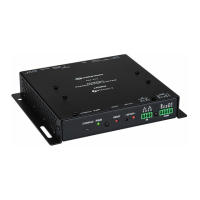6 • AirMedia Presentation Gateway Deployment Guide – DOC. 7693K
Network Infrastructure and Design Considerations
Prior to deploying AirMedia products, it is important to assess the network
infrastructure and design.
As the table in the previous section shows, AirMedia connection average bandwidth
varies from the 46Mbit/s peak of the older AM-100 firmware, to 5Mbit/s average when
sending with native macOS and iOS mirroring, and down to 1.4Mbit/s typical for
AirMedia 2.0 devices. AirMedia 2.0 is substantially better in average and peak
bandwidth, and has better quality at any given bandwidth than AM-100 and AM-101
devices.
The default peak bitrate in the Windows sender is 5Mbit/s to ensure a high-quality
experience for all types of content and a high frame rate at any resolution up to 1080p
at 30 frames per second.
The peak bitrate target can be lowered to 1Mbit/s on Windows senders, which is
adequate for most static content types. 1080p video with high motion and detail levels,
or complex motion with high foreground-background contrast such as smoke and
flames, may not display in high quality at the lowest bitrates. This is due to the
limitations of live video encoding and decoding on current devices. If this type of video
content is played consistently, a higher bandwidth quality setting is recommended.
AirMedia 2.0 devices are designed for lower latency than the older AM-101. Latency
under 60 ms has been observed in a well-designed and properly provisioned network with
ideal Wi-Fi network conditions. Older devices such as the AM-101 may experience latency
as high as 180 ms. It is difficult to specify actual latency due to the enormous variations
found in network environments. High CPU-load applications running in the background
may affect the wireless presentation experience as well.
To ensure proper bandwidth provisioning, low latency and consistent performance, the
following considerations should be taken into account.
NOTE: The following techniques are not intended to be a complete list of possible issues,
but are intended to give guidance to minimize disruption of the AirMedia experience to
end users and administrators alike.
• Manage wireless network infrastructure correctly.
• Design the network architecture between the AirMedia sender and presentation
gateway correctly.
• Minimize the impact of non-AirMedia device network traffic on the network.
Proper wireless access point design must be taken into account for a successful AirMedia
installation. While most access point vendors offer specific guidance on this subject, the
following checklist may help prevent issues at scale:
• Bandwidth requirements per access point for all use types, including AirMedia,
versus the available bandwidth the access point and non-overlapping Wi-Fi
channels provide.
• Placement of wireless access points both on and between floors of a building so
that co-channel interference is minimized. Using different antenna types and
mounting locations can assist in minimizing interference by design.

